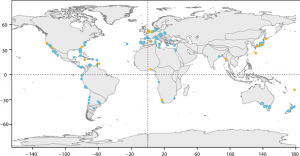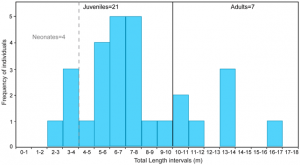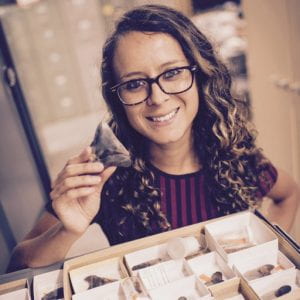Guest Author: Jack Cooper, MSc
UoB Graduate / PhD Student, University of Swansea
While a lot of recent work has gone into when Megalodon went extinct (to be discussed in detail in Saturday’s post), there’s less work regarding when exactly this giant shark first appeared. But I can tell you this with certainty: no, Megalodon was not alive when dinosaurs were still roaming the earth.

This is a surprisingly common claim in internet forums, very likely a result of the shark’s fictional portrayals. The earlier of the two low budget movies named “Megalodon” features a character stating that Megalodon “did [get so big] 65 million years ago” and Steve Alten’s first novel in his “Meg” series contains a prologue set during the Cretaceous in which a Megalodon eats a T. rex (something the film sadly left out) (Fig. 1). Bluntly, this claim is nonsense. I confess I’m a sucker for that prologue, but there is absolutely no evidence that Megalodon, or any shark named Otodus for that matter, was around at the same time as the dinosaurs. However, we do have enough recorded fossils of its teeth to give us an idea of when it first emerged and how long it was around.
Some of the earliest Megalodon teeth have been dated as far back as the early Miocene epoch (~23 million years ago), long after the last non-avian dinosaurs had kicked the bucket [1]. This was conveyed via a meta-analysis of all Megalodon occurrences reported to the Palaeobiology Database (PBDB; see Fig. 2), written up as one of the final papers in Catalina Pimiento’s PhD [1]. This work not only gave an indication of just how long Megalodon lasted as a species but also obtained a wider look at its geographic range, and its global abundance through time. As such, around 23 million years ago is suggested to be when the first baby Megalodon arrived in the world. From there, the species swam the oceans for the next 20 million years – yes, 20 million! That is an exceptionally long time for a single species, and such a big one at that, to have lived. Its extinction date has been suggested to be between 3.6 and 2.6 million years ago [2,3] (we’ll get to that in a future post). In sum, Megalodon lived for a really long time, asserting its dominance in the waters of the Miocene (23-5.3 Ma) and Pliocene (5.3-2.6 Ma) epochs.
Based on gathered fossil data from Pimiento’s PhD work [1,4], Megalodon is revealed to have had a cosmopolitan distribution, living worldwide. Its fossils have been found on every continent except Antarctica (Fig. 2). Some published sites where Megalodon teeth have been found include California and Baja California in Mexico [3], the Guadalquivir Basin in southern Spain [5], the island of Borneo [6], and the Gatun formation in Panama [7,8]. In addition, the most complete vertebral column known to the fossil record was found in the Antwerp Basin in Belgium [9].

Furthermore, sharks of the Pacific Ocean (mean – 10.9 m) were significantly larger than sharks of the Atlantic Ocean (mean – 9.53 m). While Pimiento and Balk do acknowledge in their paper that one should not rule out sampling bias (a lot more teeth from the northern hemisphere and Atlantic Ocean were obtained than from the Pacific Ocean or southern hemisphere), their large overall sample size across a 14 million year range gives their results a lot of merit. Therefore, Megalodon lived all over the world and, as far as we’re aware, the biggest specimens were possibly living in the southern Pacific Ocean.
Lastly, I want to talk about one particular site that reveals a lot about how Megalodon may have lived, specifically at an early stage of their lives. That site is the Gatun formation in Panama. Between 2007 and 2009, over 400 fossil shark teeth were excavated from this site [7]. Around 30 of those belonged to Megalodon, dated to roughly 10 million years ago (Late Miocene). These teeth were taken back to the Smithsonian Tropical Research Institution in Balboa where they were placed at the desk of Catalina Pimiento, a graduate student at the time. It occurred to her that most of these Megalodon teeth were unusually small, with crown heights as tiny as only 16 mm. It could’ve been that these were all lateral teeth found at the back of the jaw. But there was another, much more exciting possibility.
Gatun had been extensively studied before and was widely suggested to have been a highly productive, shallow marine environment back in the Miocene [7]. Such areas are perfect for shark nurseries – used by a number of species today, including the great white [10]. Nurseries are critical for the survival of young sharks, used for abundant food sources and, more importantly, protection against predators. Despite growing up to be rather formidable apex predators, even great whites are vulnerable in their early years – particularly from predation by larger sharks. Nurseries are therefore an ideal area for parent sharks to drop off their weans where they can safely grow to a size for taking on larger prey [11]. Was it possible that Megalodon had also used such a tactic? Teaming up with her MSc (and later PhD) supervisor Bruce MacFadden, as well as Dana Ehret and Gordon Hubbell, Pimiento set out to uncover if Gatun had possibly been an ancient Megalodon nursery site.
To decipher this, the authors compared the tooth sizes of the Gatun specimens to an older and a younger site, aiming to rule out a theory that Megalodon increased in size through time. Both small and large teeth were found in those sites, supporting their hunch. They then calculated TL from the Gatun teeth [7]. Mike Gottfried had previously estimated from his own calculations that Megalodon babies (neonates) were 2-4 m long, whereas juveniles were 4-10.5 m; with adult size being reached beyond 10.5 m [9]. Pimiento et al’s results revealed sharks as small as 2 m long, with most being 2-10.5 m TL (Fig. 3). Finally, comparing the teeth to dentitions collected by Hubbell revealed that their teeth came from a variety of jaw positions, and not just lateral teeth. Therefore, the authors could say with confidence that the Gatun Megalodons were mostly neonates and juveniles, indeed suggesting the presence of a nursery site. Her suspicion now supported by solid evidence, Pimiento and her co-authors published their findings in her first ever lead author paper in 2010 [7]. To this day, it remains the first result when you type “Megalodon” into Google Scholar and has 78 citations as of July 2020.


References
- Pimiento C, MacFadden BJ, Clements CF, Varela S, Jaramillo C, Velez‐Juarbe J & Silliman BR 2016. Geographical distribution patterns of Carcharocles megalodon over time reveal clues about extinction mechanisms. J. Biogeogr. 43, 1645-1655.
- Pimiento C & Clements CF 2014. When did Carcharocles megalodon become extinct? A new analysis of the fossil record. PLoS One 9, e111086.
- Boessenecker RW, Ehret DJ, Long DJ, Churchill M, Martin E & Boessenecker SJ 2019. The Early Pliocene extinction of the mega-toothed shark Otodus megalodon: a view from the eastern North Pacific. PeerJ 7, e6088.
- Pimiento C & Balk MA 2015. Body-size trends of the extinct giant shark Carcharocles megalodon: a deep-time perspective on marine apex predators. Paleobiology, 41, 479-490.
- Reolid M & Molina JM 2015. Record of Carcharocles megalodon in the Eastern Guadalquivir Basin (Upper Miocene, South Spain). Estud. Geol. 71, e032.
- Razak H & Kocsis L 2018. Late Miocene Otodus (Megaselachus) megalodon from Brunei Darussalam: Body length estimation and habitat reconstruction. Neues Jahrb. Geol. Paläontol. Abh. 288, 299–306.
- Pimiento C, Ehret DJ, MacFadden BJ & Hubbell G 2010. Ancient nursery area for the extinct giant shark Megalodon from the Miocene of Panama. PLoS One 5, e10552.
- Pimiento C, González-Barba G, Ehret DJ, Hendy AJ, MacFadden BJ & Jaramillo C 2013. Sharks and rays (Chondrichthyes, Elasmobranchii) from the late Miocene Gatun formation of Panama. J. Paleontol. 87, 755-774.
- Gottfried MD, Compagno LJV & Bowman SC 1996. Size and skeletal anatomy of the giant “megatooth” shark Carcharodon megalodon. In: Great White Sharks: the biology of Carcharodon carcharias (eds. Klimley AP & Ainley DG), 55–66, Academic Press, San Diego.
- Dewar H, Domeier M & Nasby-Lucas N 2004. Insights into young of the year white shark, Carcharodon carcharias, behavior in the Southern California Bight. Environ. Biol. Fishes 70, 133-143.
- Heupel MR, Carlson JK & Simpfendorfer CA 2007. Shark nursery areas: concepts, definition, characterization and assumptions. Mar. Ecol. Prog. Ser. 337, 287-297.
- Villafaña JA, Hernandez S, Alvarado A, Shimada K, Pimiento C, Rivadeneria MM & Kirwet J 2020. First evidence of a palaeo-nursery area of the great white shark. Sci. Rep. 10, 8502.
Edited by Rhys Charles

